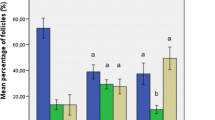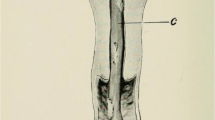Abstract
Purpose
To assess the safety of reimplantation of cryopreserved ovarian tissue from advanced-stage breast cancer patients.
Methods
Cryopreserved ovarian cortical fragments were obtained from 13 advanced-stage breast cancer patients aged 17–35 years. After thawing, part of the ovarian cortical tissue was grafted to severe combined immunodeficient mice for 6 months. The presence of malignant mammary cells in ovarian tissue was evaluated after thawing as well as after grafting by 1) histology and immunohistochemistry (epithelial membrane antigen, Her2/neu and gross cystic disease fluid protein 15 identification), and 2) detection of the MGB2 gene by qPCR.
Results
No malignant cells were evidenced by histology and immunohistochemistry. None of the mice died during the 6-month grafting period, nor developed macroscopically visible masses. MGB2 gene expression was detected by qPCR and confirmed by sequencing in frozen-thawed ovarian tissue in 4 cases and in grafts in 1 case.
Conclusions
This pilot study is the first to evaluate the risk of contamination of cryopreserved ovarian tissue from advanced-stage breast cancer patients by xenotransplantation for 6 months to immunodeficient mice, associated with more conventional screening methods. Our xenografting results are reassuring, but caution needs to be exercised, as MGB2 gene expression was detected in some cases. Larger numbers of ovarian tissue samples from patients with advanced-stage breast cancer are required to confirm our findings before ovarian tissue transplantation can be contemplated in these patients.

Similar content being viewed by others
References
Aihara T, Fujiwara Y, Ooka M, Sakita I, Tamaki Y, Monden M. Mammaglobin B as a novel marker for detection of breast cancer micrometastases in axillary lymph nodes by reverse transcription-polymerase chain reaction. Breast Cancer Res Treat. 1999;58:137–40.
Andersen CY, Rosendahl M, Byskov AG, Loft A, Ottosen C, Dueholm M, et al. Two successful pregnancies following autotransplantation of frozen/thawed ovarian tissue. Hum Reprod. 2008;23:2266–72.
Azem F, Hasson J, Ben-Yosef D, Kossoy N, Cohen T, Almog B, et al. Histologic evaluation of fresh human ovarian tissue before cryopreservation. Int J Gynecol Pathol. 2010;29:19–23.
Becker RM, Darrow C, Zimonjic DB, Popescu NC, Watson MA, Fleming TP. Identification of mammaglobin B, a novel member of the uteroglobin gene family. Genomics. 1998;54:70–8.
Braun S, Hepp F, Sommer HL, Pantel K. Tumor-antigen heterogeneity of disseminated breast cancer cells: implications for immunotherapy of minimal residual disease. Int J Cancer. 1999;84:1–5.
Breast Cancer Facts & Figures 2011–2012, American Cancer Society 2011. Available at: http://www.cancer.org/research/cancerfactsfigures/breastcancerfactsfigures/breast-cancer-facts-and-figures-2011-2012.
Choi M, Craft B, Geraci SA. Surveillance and monitoring of adult cancer survivors. Am J Med. 2011;124:598–601.
Colpaert C, Salgado R. Belgian guidelines for HER2/neu testing in breast cancer. Belg J Med Oncol. 2007;1:22–9.
Dolmans MM, Jadoul P, Gilliaux S, Amorim CA, Luyckx V, Squifflet J, et al. A review of 15 years of ovarian tissue bank activities. J Assist Reprod Genet. 2013;30:305–14.
Dolmans MM, Luyckx V, Donnez J, Andersen CY, Greve T. Risk of transferring malignant cells with transplanted frozen-thawed ovarian tissue. Fertil Steril. 2013;99:1514–22.
Dolmans MM, Marinescu C, Saussoy P, Van Langendonckt A, Amorim C, Donnez J. Reimplantation of cryopreserved ovarian tissue from patients with acute lymphoblastic leukemia is potentially unsafe. Blood. 2010;116:2908–14.
Dolmans MM, Martinez-Madrid B, Gadisseux E, Guiot Y, Yuan WY, Torre A, et al. Short-term transplantation of isolated human ovarian follicles and cortical tissue into nude mice. Reproduction. 2007;134:253–62.
Dolmans MM, Yuan WY, Camboni A, Torre A, Van Langendonckt A, Martinez-Madrid B, et al. Development of antral follicles after xenografting of isolated small human preantral follicles. Reprod BioMed Online. 2008;16:705–11.
Donnez J, Dolmans MM, Demylle D, Jadoul P, Pirard C, Squifflet J, et al. Livebirth after orthotopic transplantation of cryopreserved ovarian tissue. Lancet. 2004;364:1405–10.
Donnez J, Dolmans MM, Pellicer A, Diaz-Garcia C, Sanchez-Serrano M, Schmidt KT, et al. Restoration of ovarian activity and pregnancy after transplantation of cryopreserved ovarian tissue: a review of 60 cases of reimplantation. Fertil Steril. 2013;99:1503–13.
Donnez J, Jadoul P, Pirard C, Hutchings G, Demylle D, Squifflet J, et al. Live birth after transplantation of frozen-thawed ovarian tissue after bilateral oophorectomy for benign disease. Fertil Steril. 2012;98:720–5.
Donnez J, Martinez-Madrid B, Jadoul P, Van Langendonckt A, Demylle D, Dolmans MM. Ovarian tissue cryopreservation and transplantation: a review. Hum Reprod Update. 2006;12:519–5.
Durant JF, Fonteyne PA, Richez P, Marot L, Belkhir L, Tennstedt D, et al. Real-time PCR and DNA sequencing for detection and identification of Trichophyton rubrum as a cause of culture negative chronic granulomatous dermatophytosis. Med Mycol. 2009;47:508–14.
Gagnon Y, Têtu B. Ovarian metastases of breast carcinoma. A clinicopathologic study of 59 cases. Cancer. 1989;64:892–8.
Gillanders WE, Mikhitarian K, Hebert R, Mauldin PD, Palesch Y, Walters C, et al. Molecular detection of micrometastatic breast cancer in histopathology-negative axillary lymph nodes correlates with traditional predictors of prognosis: an interim analysis of a prospective multi-institutional cohort study. Ann Surg. 2004;239:828–37.
Gosden RG, Baird DT, Wade JC, Webb R. Restoration of fertility to oophorectomized sheep by ovarian autografts stored at −196 degrees C. Hum Reprod. 1994;9:597–603.
Harvey JM, Clark GM, Osborne CK, Allred DC. Estrogen receptor status by immunohistochemistry is superior to the ligand-binding assay for predicting response to adjuvant endocrine therapy in breast cancer. J Clin Oncol. 1999;17:1474–81.
Kim SS, Lee WS, Chung MK, Lee HC, Lee HH, Hill D. Long-term ovarian function and fertility after heterotopic autotransplantation of cryobanked human ovarian tissue: 8-year experience in cancer patients. Fertil Steril. 2009;91:2349–54.
Kyono K, Doshida M, Toya M, Sato Y, Akahira J, Sasano H. Potential indications for ovarian autotransplantation based on the analysis of 5,571 autopsy findings of females under the age of 40 in Japan. Fertil Steril. 2010;93:2429–30.
Lacroix M. Significance, detection and markers of disseminated breast cancer cells. Endocr Relat Cancer. 2006;13:1033–67.
Lau SK, Weiss LM, Chu PG. Differential expression of MUC1, MUC2, and MUC5AC in carcinomas of various sites: an immunohistochemical study. Am J Clin Pathol. 2004;122:61–9.
Li CI, Anderson BO, Daling JR, Moe RE. Trends in incidence rates of invasive lobular and ductal breast carcinoma. JAMA. 2003;289:1421–4.
Moreno-Bueno G, Sánchez-Estévez C, Cassia R, Rodríguez-Perales S, Díaz-Uriarte R, Domínguez O, et al. Differential gene expression profile in endometrioid and nonendometrioid endometrial carcinoma: STK15 is frequently overexpressed and amplified in nonendometrioid carcinomas. Cancer Res. 2003;63:5697–702.
Müller-Schöttle F, Classen-Linke I, Beier-Hellwig K, Sterzik K, Beier HM. Uteroglobin expression and release in the human endometrium. Ann N Y Acad Sci. 2000;923:332–5.
Nissan A, Jager D, Roystacher M, Prus D, Peretz T, Eisenberg I, et al. Multimarker RT-PCR assay for the detection of minimal residual disease in sentinel lymph nodes of breast cancer patients. Br J Cancer. 2006;94:681–5.
Oktay K. Ovarian tissue cryopreservation and transplantation: preliminary findings and implications for cancer patients. Hum Reprod Update. 2001;7:526–34.
Oktay K. Further evidence on the safety and success of ovarian stimulation with letrozole and tamoxifen in breast cancer patients undergoing in vitro fertilization to cryopreserve their embryos for fertility preservation. J Clin Oncol. 2005;23:3858–9.
Oktay K, Buyuk E, Veeck L, Zaninovic N, Xu K, Takeuchi T, et al. Embryo development after heterotopic transplantation of cryopreserved ovarian tissue. Lancet. 2004;363:837–40.
Ouellette RJ, Richard D, Maïcas E. RT-PCR for mammaglobin genes, MGB1 and MGB2, identifies breast cancer micrometastases in sentinel lymph nodes. Am J Clin Pathol. 2004;121:637–43.
Perrotin F, Marret H, Bouquin R, Fischer-Perrotin N, Lansac J, Body G. Incidence, diagnosis and prognosis of ovarian metastasis in breast cancer. Gynecol Obstet Fertil. 2001;29:308–15.
Rosendahl M, Timmermans Wielenga V, Nedergaard L, Kristensen SG, Ernst E, Rasmussen PE, et al. Cryopreservation of ovarian tissue for fertility preservation: no evidence of malignant cell contamination in ovarian tissue from patients with breast cancer. Fertil Steril. 2011;95:2158–61.
Sánchez-Serrano M, Crespo J, Mirabet V, Cobo AC, Escribá MJ, Simón C, et al. Twins born after transplantation of ovarian cortical tissue and oocyte vitrification. Fertil Steril. 2010;93:268.
Sánchez-Serrano M, Novella-Maestre E, Roselló-Sastre E, Camarasa N, Teruel J, Pellicer A. Malignant cells are not found in ovarian cortex from breast cancer patients undergoing ovarian cortex cryopreservation. Hum Reprod. 2009;24:2238–43.
Taback B, Chan AD, Kuo CT, Bostick PJ, Wang HJ, Giuliano AE, et al. Detection of occult metastatic breast cancer cells in blood by a multimolecular marker assay: correlation with clinical stage of disease. Cancer Res. 2001;61:8845–50.
Tassi RA, Bignotti E, Rossi E, Falchetti M, Donzelli C, Calza S, et al. Overexpression of mammaglobin B in epithelial ovarian carcinomas. Gynecol Oncol. 2007;105:578–85.
Telfer EE, McLaughlin M. In vitro development of ovarian follicles. Semin Reprod Med. 2011;29:15–23.
Telfer EE, McLaughlin M, Ding C, Thong KJ. A two-step serum-free culture system supports development of human oocytes from primordial follicles in the presence of activin. Hum Reprod. 2008;23:1151–8.
Tornos C, Soslow R, Chen S, Akram M, Hummer AJ, Abu-Rustum N, et al. Expression of WT1, CA 125, and GCDFP-15 as useful markers in the differential diagnosis of primary ovarian carcinomas versus metastatic breast cancer to the ovary. Am J Surg Pathol. 2005;29:1482–9.
Van Eyck AS, Bouzin C, Feron O, Romeu L, Van Langendonckt A, Donnez J, et al. Both host and graft vessels contribute to revascularization of xenografted human ovarian tissue in a murine model. Fertil Steril. 2010;93:1676–85.
Vanacker J, Camboni A, Dath C, Van Langendonckt A, Dolmans MM, Donnez J, et al. Enzymatic isolation of human primordial and primary ovarian follicles with Liberase DH: protocol for application in a clinical setting. Fertil Steril. 2011;96:379–83.
Wallwiener CW, Wallwiener M, Kurth RR, Röhm C, Neubauer H, Banys MJ, et al. Molecular detection of breast cancer metastasis in sentinel lymph nodes by reverse transcriptase polymerase chain reaction (RT-PCR): identifying, evaluating and establishing multi-marker panels. Breast Cancer Res Treat. 2011;130:833–44.
Watson MA, Dintzis S, Darrow CM, Voss LE, DiPersio J, Jensen R, et al. Mammaglobin expression in primary, metastatic, and occult breast cancer. Cancer Res. 1999;59:3028–31.
Watson MA, Fleming TP. Mammaglobin, a mammary-specific member of the uteroglobin gene family, is overexpressed in human breast cancer. Cancer Res. 1996;56:860–5.
Acknowledgments
The present study was supported by grants from the Fonds National de la Recherche Scientifique de Belgique (Grant Télévie n°7.4507.10, grant 3.4.590.08), the Fondation St Luc, the Foundation Against Cancer, and the Centre du Cancer, and donations from Mr Pietro Ferrero, Baron Albert Frère and Viscount Philippe de Spoelberch.
The authors thank Mira Hryniuk for reviewing the English language of the manuscript and Dolores Gonzalez for her technical assistance. They also thank the biobank for providing samples of breast tumors and normal ovarian fragments.
Author information
Authors and Affiliations
Corresponding author
Additional information
Capsule Cryopreserved ovarian tissue from advance-stage breast cancer patients is potentially unsafe for transplantation.
Electronic supplementary material
Below is the link to the electronic supplementary material.
Supplemental Table 1
(DOC 32 kb)
Supplemental Fig. 1
(PPT 40 kb)
Supplemental Fig. 2
(DOC 37 kb)
Rights and permissions
About this article
Cite this article
Luyckx, V., Durant, J.F., Camboni, A. et al. Is transplantation of cryopreserved ovarian tissue from patients with advanced-stage breast cancer safe? A pilot study. J Assist Reprod Genet 30, 1289–1299 (2013). https://doi.org/10.1007/s10815-013-0065-3
Received:
Accepted:
Published:
Issue Date:
DOI: https://doi.org/10.1007/s10815-013-0065-3




